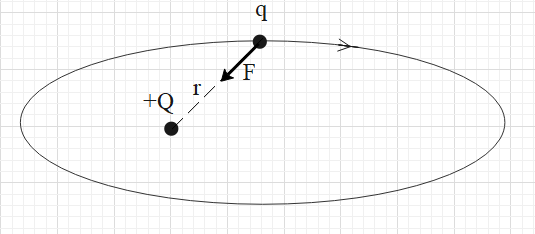
Answer
461.1k+ views
Hint: Check whether the torque on the charge q due the force exerted by charge +Q about a point on charge +Q is zero. Note that torque is defined as the rate of change in angular momentum of the particle with respect to time.
Formula used:
$\tau =Fr$
$\tau =\dfrac{dL}{dt}$
$L=I\omega $
Complete answer:
For a particle to revolve around another particle, there must be a force attraction between the two particles. It is given that a charge q is revolving around a charge +Q in an elliptical orbit. We know that unlike charges, they attract each other. Therefore, the revolving charge q must be a negative charge.
Therefore, the +Q charge will exert a force of attraction on the charge q. The electrostatic force of attraction is always towards the charge that exerts the force. This means that the direction of the force on charge q is towards charge +Q.

The magnitude of torque on the charge about a point is equal to the product of the distance (r) between the two charges and the component of the force that is normal to r.
i.e. $\tau =Fr$.
In this case, torque about charge +Q is zero because the component of the force normal to r is zero.
i.e. $\tau =0$
And torque is defined as the rate of change in the angular momentum about the same point with respect to time.
i.e. $\tau =\dfrac{dL}{dt}$.
This means that the change in the angular momentum of charge q is zero. In other words, the angular momentum of charge q is constant.
So, the correct answer is “Option A”.
Note:
Angular momentum is given as the product of the momentum of inertia (I) and the angular velocity ($\omega $) of the particle about the same point.
i.e. $L=I\omega $.
When the charge q is moving in the elliptical path, its momentum of inertia is continuously changing because the distance of the charge q from charge Q is changing. We know that L is constant. Therefore, if I is changing then $\omega $ is also changing.
When a particle revolves in an elliptical orbit, its linear speed changes. Since the linear speed changes, the linear momentum also changes.
Formula used:
$\tau =Fr$
$\tau =\dfrac{dL}{dt}$
$L=I\omega $
Complete answer:
For a particle to revolve around another particle, there must be a force attraction between the two particles. It is given that a charge q is revolving around a charge +Q in an elliptical orbit. We know that unlike charges, they attract each other. Therefore, the revolving charge q must be a negative charge.
Therefore, the +Q charge will exert a force of attraction on the charge q. The electrostatic force of attraction is always towards the charge that exerts the force. This means that the direction of the force on charge q is towards charge +Q.

The magnitude of torque on the charge about a point is equal to the product of the distance (r) between the two charges and the component of the force that is normal to r.
i.e. $\tau =Fr$.
In this case, torque about charge +Q is zero because the component of the force normal to r is zero.
i.e. $\tau =0$
And torque is defined as the rate of change in the angular momentum about the same point with respect to time.
i.e. $\tau =\dfrac{dL}{dt}$.
This means that the change in the angular momentum of charge q is zero. In other words, the angular momentum of charge q is constant.
So, the correct answer is “Option A”.
Note:
Angular momentum is given as the product of the momentum of inertia (I) and the angular velocity ($\omega $) of the particle about the same point.
i.e. $L=I\omega $.
When the charge q is moving in the elliptical path, its momentum of inertia is continuously changing because the distance of the charge q from charge Q is changing. We know that L is constant. Therefore, if I is changing then $\omega $ is also changing.
When a particle revolves in an elliptical orbit, its linear speed changes. Since the linear speed changes, the linear momentum also changes.
Recently Updated Pages
Fill in the blanks with suitable prepositions Break class 10 english CBSE

Fill in the blanks with suitable articles Tribune is class 10 english CBSE

Rearrange the following words and phrases to form a class 10 english CBSE

Select the opposite of the given word Permit aGive class 10 english CBSE

Fill in the blank with the most appropriate option class 10 english CBSE

Some places have oneline notices Which option is a class 10 english CBSE

Trending doubts
Fill the blanks with the suitable prepositions 1 The class 9 english CBSE

How do you graph the function fx 4x class 9 maths CBSE

When was Karauli Praja Mandal established 11934 21936 class 10 social science CBSE

Which are the Top 10 Largest Countries of the World?

What is the definite integral of zero a constant b class 12 maths CBSE

Why is steel more elastic than rubber class 11 physics CBSE

Distinguish between the following Ferrous and nonferrous class 9 social science CBSE

The Equation xxx + 2 is Satisfied when x is Equal to Class 10 Maths

Differentiate between homogeneous and heterogeneous class 12 chemistry CBSE




